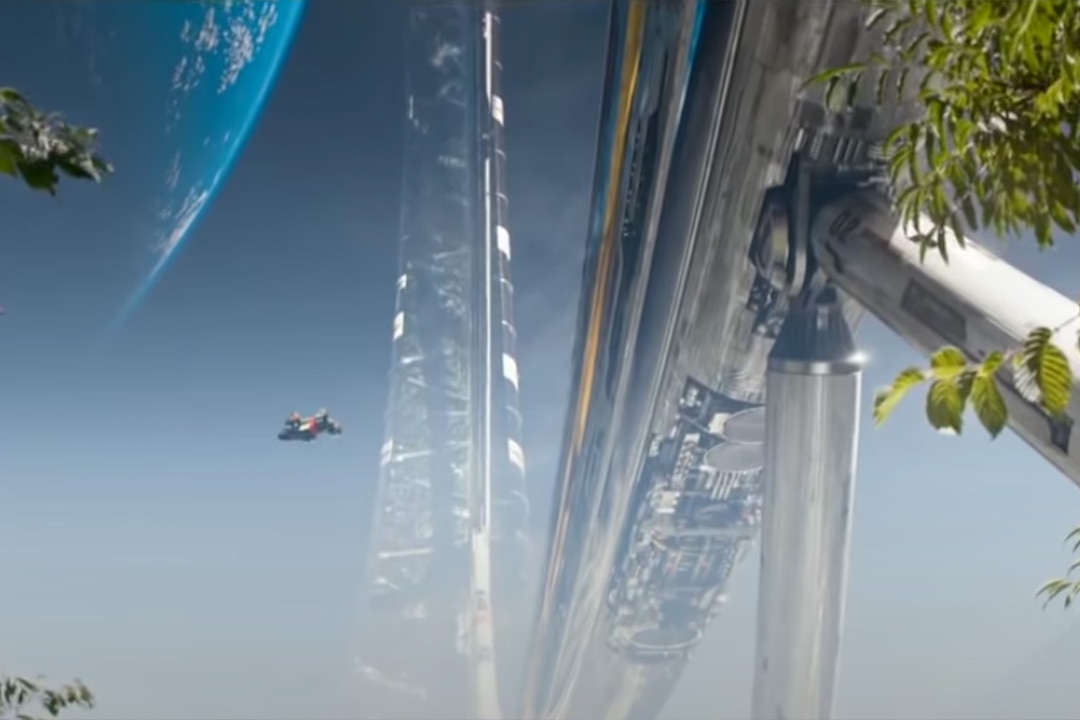Create a free profile to get unlimited access to exclusive videos, sweepstakes, and more!
NASA wants to build a 'space tug' to safely destroy the ISS
Safely crashing a spaceship isn't easy.

In 2009, Neill Blomkamp hit the public consciousness harder than a downed spacecraft with his feature film debut, District 9. The movie established Blomkamp’s signature style, which mashes dire and dingy real-world environments with high-flying futuristic tech and creatures. That aesthetic came back with a vengeance in Blomkamp’s 2013 sophomore film, Elysium (now streaming on Peacock!) starring Matt Damon and Jodie Foster.
The story takes place on Earth in the year 2154. More accurately, part of the story takes place on Earth. The rest revolves around and takes place upon an orbital space station called Elysium. Nearly a century and a half in the future, the Earth is overwhelmed by the needs of humanity and most people live in squalor on the planet’s surface, struggling to survive. The wealthy elite, however, live out their days on a luxury space station, visible but forever out of reach in the sky.
Max Da Costa (Damon) is a criminal on parole when he is exposed to a lethal dose of radiation on the job. He’s given a pink slip, a pat on the back, and five days to live. Rather than go home and wait for the end to come, Max embarks upon a life and death mission to get to the station, break in, and use one of their high-tech med bays to cure his fatal condition before it’s too late.
By the time the credits roll, Max and his friends have succeeded in destroying the power structure which kept them eternally have-nots, but it’s only a matter of time before the physical distance between Earth and Elysium results in the same sort of altitude-based class system all over again. If they really want to prevent that kind of power disparity from happening again they might need to bring the station down for good. Of course, that isn’t the easiest thing to accomplish, as our own scientists and engineers know all too well.
In recent years, we have witnessed multiple large craft crashing back to Earth in an uncontrolled descent. One of them even smashed into the Moon, giving our closest cosmic neighbor a couple of new craters.
RELATED: NASA mission spots Chinese rocket impact craters on the Moon
So far, we have avoided any catastrophic accidents caused by pieces of disintegrating spacecraft coming down over populated areas, but letting rockets and orbital labs fall back to Earth wherever they feel like is a recipe for disaster sooner or later. That’s especially true when dealing with the International Space Station, which is the largest artificial object we have ever put in space.
Over the last few decades, members of five space agencies and dozens of nations all over the world have come together to build modules, carry out experiments, and live in space together. The result is a truly massive machine, 310 feet (94 meters) long and nearly as wide, all racing through space at more than 17,000 miles per hour, 250 miles above the Earth. It’s not the sort of thing you want coming down just anywhere. But come down it must.
At present, the ISS is scheduled for decommissioning in 2030, at which point we’ll need to figure out what to do with it. So far, the plan has been for Russia’s Roscosmos to provide robotic Progress vehicles – uncrewed craft similar to the Soyuz – which would deorbit the station through a series of engine burns. Each burn would slow the station down, reducing its altitude and eventually pushing it into the atmosphere, where it will break up. However, Russia has indicated a desire to leave the station earlier, potentially in the next couple of years, in order to pursue their own orbital station. All of which appears to have driven NASA to come up with their own deorbit solution.
A surprise in the 2024 budget request reveals that NASA isn’t comfortable relying on Roscosmos to make sure the ISS comes down safely. The budget request, which totals more than $27 billion, includes $8.1 billion to support the Artemis program. That would cover rockets, crew vehicles, landers, space suits, and more for Artemis II and III.
RELATED: How do NASA’s new Artemis space suits stack up against our favorite sci-fi gear?
In addition, the budget allocates $180 million to begin the development of a “space tug” designed to safely de-orbit the International Space Station in such a way that it comes down over the open ocean. The budget proposal says, in part, “The International Space Station will need to be safely deorbited at the end of its operational life as the United States transitions to lower-cost commercial space stations. Rather than relying on Russian systems that may not be able to accomplish this task, the Budget provides $180 million to initiate development of a new space tug that may also be useful for other space transportation missions.”
That $180 million amount is only the beginning of the project with the total cost of the vehicle expected to be much higher. During a press conference to discuss the budget proposal, NASA’s human spaceflight chief, Kathy Lueders, said their initial estimate for the cost of the space tug came in at just under a billion dollars. Their plan is to approach contractors for proposals, which should bring the cost down somewhat.
That said, you can’t really put a price on NOT getting smooshed by a research laboratory the size of a football field. Whatever the cost is, we should probably pay it.
When the ISS does eventually come down, try to imagine Elysium (now streaming on Peacock) instead of the coolest scientific laboratory we’ve ever made. It’ll help to relieve the pain.



























